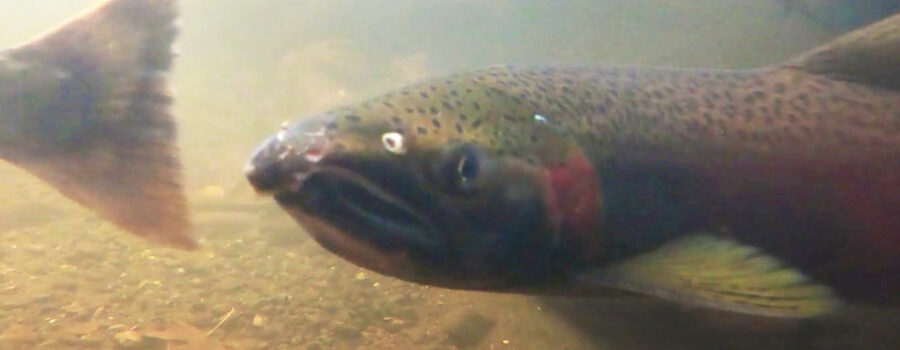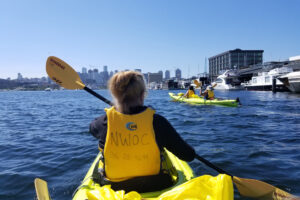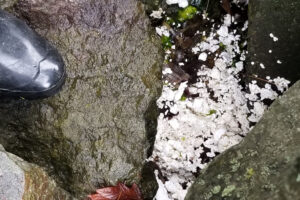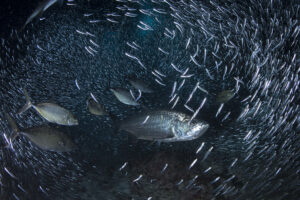We have known for some time that one or more chemicals in our stormwater runoff kills Coho salmon, but haven’t known which specific chemical to blame. Now, we do.
Teams of scientists from Washington State University (WSU), the University of Washington in Tacoma (UW), and NOAA Fisheries worked in collaboration for more than 20 years to eliminate thousands of possibilities and solve the mystery. Chemists at UW released breakthrough research this month that identifies the culprit – a previously unknown chemical compound called 6-PPD-quinone (C18H22N2O2).1
They determined 6-PPD-quinone is created from a reaction between the ozone from car exhaust and the primary antioxidant chemical used in tires to keep ozone from degrading them. It’s a bitter irony.

When the roads are wet, our tires leach 6-PPD-quinone into our stormwater runoff, which then flows into our urban waterways and kills the Coho. This condition is called Urban Runoff Mortality Syndrome (URMS) and has been killing upwards of 80% of Coho salmon just before they get a chance to spawn in our local urban streams.2 (See my post entitled What’s killing the Coho salmon?) We do not yet know how many other species in the ecosystem are also being poisoned by this chemical.
The hunt for a killer
For more than 20 years, teams of biologists and chemists including Dr. Jenifer McIntyre at WSU, Dr. Ed Kolodziej, and Zhenyu Tian at the Center for Urban Waters at UW Tacoma, collaborated to isolate this chemical. Think about how hard this must have been. It’s similar to “looking for a needle in a haystack” except that they were looking for some unknown thing in a haystack, and the clock was ticking.
In 2011, after an eight-year study, biologists were able to eliminate disease, the physical condition of the fish, household pesticides, high temperature, low oxygen, or ammonia in the water as possible causes and focus on stormwater.3 Our communities release a toxic brew of motor oil, antifreeze, fertilizers, pesticides, heavy metals, and other chemicals into stormwater. What chemicals were in the water when the fish died? Was it just one chemical or the interaction of many chemicals that caused the fish to die?
By 2015, biologists could point to chemicals in automobiles as the likely source. Chemists from UW now joined the hunt. By 2018, they narrowed down the search to chemicals from car tires. By 2020, they were able to isolate and identify 6-PPD-quinone as the culprit.
6-PPD-quinone is not a chemical that engineers put in tires. It wasn’t on any list of possible chemicals to investigate. UW chemists discovered it and determined it is created through the interaction of a chemical in tires with ozone in the surrounding environment. I can only imagine the discipline required to systematically eliminate thousands of possibilities and zero-in on a chemical no one knew existed.
UW produced this video (runtime 02:47) explaining how the teams worked to find the answer:
Calling up a posse
UW and WSU scientists are the heroes of this story, but monitoring streams on a daily basis is labor-intensive, so they worked in partnership with local citizens. Puget Soundkeeper mobilized and trained teams of volunteers each year to collect data for the ongoing research. I joined the volunteer effort this year.
For eight weeks starting in mid-October, 19 volunteers armed with waders, walking sticks, cameras, and necropsy kits surveyed a 330-meter stretch of Longfellow Creek to document the number of Coho affected by Urban Runoff Mortality Syndrome. Each day, a team of 2-3 people walked the banks, crawled through the brush, hopped across rocks, traversed logs, and, only when necessary, stepped gingerly through the creek in search of returning Coho.

The search for affected fish
Finding a 20-inch-long Coho in a small creek turns out to be a lot harder than you might think. First, they have excellent camouflage. If they are not moving, the spotted coloring along their backs helps them disappear in the shadows of the gravelly-bottomed sections of the stream. Even the signature red color of the males can be hard to spot.

Second, if you aren’t looking through a polarized lens, it is almost impossible to see through the glare on the surface of the water. And finally, when the creek floods, the faster-moving water stirs up sediment which can reduce visibility to nearly zero.
All of these challenges require you to get down close to the creek bed, to walk slowly and then hold still for a while so that the fish are not stressed by your presence and come out of hiding. Covering the 330-meter length of the survey site in this way takes about 1-2 hours.

Measuring the impact
When you can see one, this relatively narrow and shallow creek makes a 20-inch fish seem even bigger than it is. Some of them look quite healthy with bright, clear skin, and agile, graceful movement. Others look like they have taken a beating, with their skin scraped and falling away from their bodies as they swim warily and hide in the shadows. The 900 meter uphill swim they make through a culvert that allows them to pass from the Duwamish River into the creek must be a pretty rough passage when the water level is low.
In each daily survey, our teams counted fish, noted the species (Coho, Chum, or Steelhead), sex, and location within the creek. We marked any redds with red tape on a nearby bush so that people could take care to not step on them. We noted sick fish and conducted necropsies on fish that had already died.

A necropsy is an autopsy that is performed on an animal. When we found a dead fish, we recorded its length and girth. If it was a female, we opened its belly with a knife to see if she had already released her eggs. If her belly was still largely full of eggs, we confirmed her death as pre-spawn mortality. When the reporting was complete, we cut off its tail as a signal to other surveyors that it had already been counted. Puget Soundkeeper then notified the research teams to come to the creek to collect water and Coho tissue samples.
Our teams logged 18 sightings of Coho over eight weeks. That number includes individual fish seen multiple times. After counting only dead fish, to eliminate the risk of double counting, we could confirm 7 Coho in the stream this year. That number continues the decline seen over the last 20 years. They ranged in length from 11 to 23 inches (29-58 cm). We found that 83% of the Coho we examined died from Urban Runoff Mortality Syndrome. Of the 7 dead Coho, 4 were female, and of those, 3 were confirmed to have died with their bellies largely still full of eggs. That means only 1 female Coho successfully spawned in the creek this year.4 For them to come so close to fulfilling their destiny only to fail is devastating to the effort to maintain viable Coho populations.
Longfellow Creek is not unique
The Salish Sea watershed affords a rich network of rivers and tributaries for Coho runs. In some waterways, Coho barely experience any pre-spawn mortality. In others, many of the annual runs of mature adults are being largely wiped out before they can spawn.
Using data collected at Longfellow Creek and five other sites, NOAA Fisheries prepared this map in 2011 to predict the effect on Coho throughout the watershed.

The key characteristic for success or failure in each basin is urbanization. If the stream is in a densely urban area with close proximity to roads, impervious surfaces, and commercial property, the death rate for Coho is significantly higher.5 Unless we make changes to prevent polluted stormwater from entering our streams, more and more Coho runs will fail.
We have to believe that Coho is not the only species in the ecosystem that is vulnerable to this chemical. Are other animals dying? Does it affect humans? We don’t know yet, but think about that the next time you play on a synthetic crumb rubber turf field or playground. The US EPA was supposed to release research into concerns about recycled tire crumb used on playing fields in 2019, but the results have been delayed.6
Although none of us intended to poison these fish, we are responsible. Thanks to the scientists at UW and WSU, we know what the problem is. Now it is time for us to act.
Acting on the UW discovery
Given the decline in the number of returning Coho and their intense vulnerability to this toxin, we are running out of time to help them. We need to work quickly to get tire manufacturers to change the chemistry of their tires. The existence of 6-PPD-quinone is an unintended consequence of more than 100 years of innovation designed to make tires last longer and keep people safe on the road. Now we need innovation to keep people and our ecosystem safe from toxins as well.
It would be great if we can persuade tire manufacturers to voluntarily change the chemistry of their tires. If they won’t, then our only recourse is to legislate. Experts recognize Washington State’s “toxics in products laws” to be the strongest in the country.7 We have a “Better Brakes” law (Chapter 173-901 WAC) in place that phases out copper and bans asbestos and other chemicals from brake pads.8 It’s time for us to adopt a “Better Tires” law to remove toxins linked to our tires.
We need to make this change quickly. If we spend years arguing about the dollar cost of change while doing nothing, it seems likely that the costs to our ecosystem will mount and we will lose our Coho populations in the Salish Sea and other urbanized watersheds.
What can we do?
While legislative wheels turn, filtering stormwater runoff before it runs directly into streams is the best we can do. (Again, see my post entitled What’s killing the Coho salmon?) To do this, we need to 1) change our behavior and 2) change our infrastructure:
Change our behavior
Reduce pollutants entering stormwater:
- Call on your elected officials to stand up for the US Clean Water Act, the US Endangered Species Act, and to follow the “Better Brakes” law with a “Better Tires” law.
- Prevent liquid and solid waste from entering gutters or stormwater drains. Review your city’s or county’s website for disposal options, such as the Hazardous Waste Management Program for King County or the Rainwise program for Seattle.
- Use commercial car washes that collect and recycle dirty water.
- Fix leaks in your car to keep oil, antifreeze, and other fluids from landing on the pavement.
- Avoid using recycled tire material for garden mulch, children’s playgrounds, or sport courts.
- Use compost or non-toxic fertilizers and pesticides in your garden or on your farm.
- Pick up your pet’s waste and put it in the trash bin, not the compost bin.
Change our infrastructure
Design infrastructure to provide the flood control and filtration services that the forests originally provided before our communities were built:
- Avoid using recycled tire material for drainage foundations.
- Build a rain garden on your property to capture runoff from your roof to allow water to slowly seep into the soil and be filtered naturally. Get started with this Rain Garden Handbook from the Washington Department of Ecology.
- Construct hard surfaces such as sidewalks and parking lots with pervious concrete or asphalt that allows water to seep into the soil underneath.
- Create bioswales next to roadways, parking lots, or sidewalks that can’t be made porous to capture runoff and allow it to seep into the soil.
- Avoid building too close to the streams and rivers, providing healthy buffer zones, called riparian borders, that can filter urban runoff before it enters a stream.
Go Deeper!
Go Deeper to explore the ocean and the Salish Sea through a curated list of articles, books, films, and other resources. To learn more about the topic in this article, check out the following resources:
- Scientists hunt down deadly chemical that kills coho salmon
- Timeline: The search to find a chemical that kills coho salmon in urban streams
- The history and chemistry of tires
- Broken Fish: Collapse of the Coho | 2018 Short Film (runtime 00:14:35)
- Coho Urban Runoff Mortality Syndrome in Puget Sound (runtime 00:05:52)
- Coho Pre-Spawn Mortality on Longfellow Creek (PDF)
- Innovative Stormwater Management at the Neighbourhood Scale (runtime 00:14:18)
- Rain Garden Handbook for Western Washington (PDF)
- Hazardous Waste Management Program in King County
- Rainwise Rebate Program in Seattle
- Stormwater services and information in King County
Acknowledgments
- Thanks to Gillian Flippo and Kristin Holschbach of Puget Soundkeeper for mobilizing and training teams of volunteers to learn about and support this research.
- Thanks to Molly Allen for reviewing and improving this post.
- Thanks to Christoper Dunagan of the Puget Sound Institute at the University of Washington for directing me to additional research resources.
End Notes
1 Dunagan, Christopher. “Scientists Hunt down Deadly Chemical That Kills Coho Salmon.” Encyclopedia of Puget Sound, The Puget Sound Institute at the University of Washington Tacoma, 3 Dec. 2020, www.eopugetsound.org/magazine/IS/coho-and-tires.
2 “Introduction.” Coho Urban Runoff Mortality Syndrome in Puget Sound, Washington Fish and Wildlife Office, NOAA, Washington State University, The Nature Conservancy, 2019, fws.maps.arcgis.com/apps/MapSeries/index.html?appid=5dd4a36a2a5148a28376a0b81726a9a4.
3 Dunagan, Christopher. “Timeline: The Search to Find a Chemical That Kills Coho Salmon in Urban Streams.” Encyclopedia of Puget Sound, The Puget Sound Institute at the University of Washington Tacoma, 3 Dec. 2020, www.eopugetsound.org/magazine/IS/20-years-of-science.
4 Puget Soundkeeper, unpublished data, December, 2020.
5 Feist, Blake E, et al. “Landscape Ecotoxicology of Coho Salmon Spawner Mortality in Urban Streams.” PloS One, Public Library of Science, 17 Aug. 2011, www.ncbi.nlm.nih.gov/pmc/articles/PMC3157375/.
6-7 Holden, Emily. “US Playgrounds: Fears Grow over Health Risks from Rubber Particles.” The Guardian, Guardian News and Media, 25 June 2019, www.theguardian.com/us-news/2019/jun/25/lawmakers-concerned-chemicals-rubber-playgrounds-push-safety-rules.
8 “Washington’s Toxics in Products Laws.” Washington’s Toxics in Products Laws – Washington State Department of Ecology, ecology.wa.gov/Waste-Toxics/Reducing-toxic-chemicals/Washingtons-toxics-in-products-laws.






Leave a Reply
Your comments are welcome.